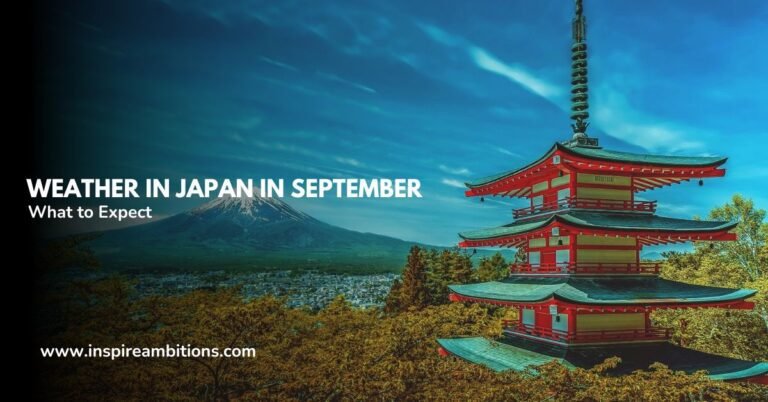What is Japan Like – A Snapshot of the Land of the Rising Sun
Japan, an island nation in East Asia, is a place where ancient traditions blend with modern life. The country has over 6,800 islands, but most people live on four large ones:
Honshu, Hokkaido, Kyushu, and Shikoku. With a population of about 125 million, it’s pretty crowded, but the culture of respect makes it work smoothly.
The capital, Tokyo, is a massive city with fantastic technology, but you can still find peaceful gardens and temples.
Across Japan, you’ll see that nature is essential, and there are beautiful mountains and forests. One famous mountain is Mount Fuji – it’s the highest in Japan and looks fantastic, especially when there’s snow on the top.
When you’re in Japan, you’ll notice lots of cool stuff about its culture. They have great food—not just sushi!
There are also neat traditions, like tea ceremonies, and everyone is very polite. And the toilets are high-tech; they have buttons to wash and dry you, which is pretty fun to try. Japan is a unique place, and if you ever visit Asia, it should definitely be on your list!
Exploring Japanese Culture and Traditions
Japanese culture offers a fascinating blend of ancient traditions and contemporary practices. Here’s a peek into the arts, dining, and historical governance of this unique country.
Arts and Festivals
Japan’s cultural landscape is rich with various forms of कला. Traditional arts include sado (tea ceremony), kado (flower arranging), shodo (calligraphy), and the cultivation of bonsai trees. Each of these arts requires meticulous attention to detail and embodies the philosophy of wa (harmony).
The Japanese festival scene is vibrant and packed with events throughout the year. Notable festivities include the Cherry Blossom festivals that occur in the spring when pink and white blossoms paint the country in soft hues. Festivals often feature locals in kimonos, traditional Japanese garments, and a wide range of street food offerings.
भोजन एवं भोजन
When it comes to cuisine, Japan is known for more than just sushi और ramen. The dining experience is a formality in itself, where presentation and etiquette hold great importance. Seafood is a staple, but dishes also include a variety of meat, noodles, and vegetables.
Sake, a rice-based alcohol, often accompanies meals. Have you tried the unique flavours of Japanese ice cream, like green tea or sweet potato?
रेस्टोरेंट in Japan range from street-side yatai stalls to formal kaiseki dining that reflects the seasonal change in a multi-course meal. When you visit a local eatery, tasting the different foods is an adventure in itself.
History and Government
Japan’s इतिहास is marked by eras of peace and times of war, including significant events like World War II. The samurai warrior is a storied figure from Japan’s past, embodying the values of loyalty and honour. Today, Japan is a संवैधानिक राजतंत्र, with an Emperor as the symbol of the state.
The सरकार operates under a parliamentary system and is divided into two chambers: the House of Councillors और यह House of Representatives. These two houses form the National Diet, Japan’s highest legislative body. Understanding Japan’s governance provides insights into how its historical values influence contemporary policies.
Travel and Geography
Japan, an island nation in East Asia, offers a riveting blend of ancient history and modern wonders. Its diverse landscapes encompass bustling metropolitan areas and serene natural beauty, with a climate as varied as its terrain.
Major Cities and Regions
Tokyo is the pulsating heart of Japan as both the capital and the largest city. When you explore Tokyo, you’ll find a vibrant mix of the latest trends, historic temples, and everything in between. Looking further, each region of Japan boasts its unique appeal:
- Hokkaido, known for Sapporo and its snowy landscapes, promises adventure with skiing and snowboards.
- Moving south, Honshu houses most of Japan’s significant cities, including Kyoto, the hub of traditional culture and history, and Hiroshima and Nagasaki, which are cities rebuilt with peace at their core.
- Shikoku invites you to the peace of the countryside and pilgrimages through temples.
- Kyushu is soaked in natural beauty, with hot springs in cities like Fukuoka and Kagoshima.
- अंततः, Okinawa offers a tropical experience, unlike the rest of Japan, with a rich history and sandy beaches.
Each corner of Japan tells a different story, from the snowy mountains to seaside villages.
Nature and Climate
The very fabric of Japan is woven with प्रकृति and its dramatic जलवायु. With over half the country cloaked in mountains and forests, it’s a hiker’s wonderland. Speaking of mountains, Mount Fuji stands as a majestic symbol of Japan, its iconic snow-capped peak inspiring awe and reverence.
The Japanese Alps stretch through the heart of Honshu, showcasing the grandeur of Japan’s mountainous terrain. Meanwhile, regions like Gifu and Mie give you glimpses of Japan’s natural diversity and traditional architecture, nestled between mountains and sea.
Japan’s climate ranges from the powdery winter snows of Hokkaido to the subtropical warmth of Okinawa. But be mindful—Japan’s position along the Pacific ring of Fire makes it prone to earthquakes और tsunamis.
This nation of islands is shaped and influenced by the surrounding seas: the Sea of Japan, the Sea of Okhotsk, and the East China Sea, each contributing to Japan’s maritime heritage and climatic influences. With each visit, you’ll encounter a different aspect of Japan’s weather, confirming that it’s a place for all seasons and reasons.






